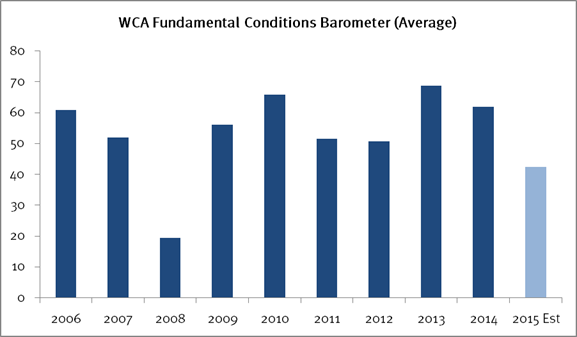2015 Needs a Boost
The WCA Fundamental Conditions Barometer remains weak reflecting slower global growth. Our updated forecast has the barometer tracking toward 43 for October and remaining in the 40-45 range for the fourth quarter of the year. The bright spot remains domestic final demand which continues to plow forward on steady improvement in employment and wages. The pickup we saw from the second quarter is not continuing into the third quarter and both the IMF and the Atlanta Fed’s GDP Now forecast are being trimmed. The IMF again revised its global growth rate down to an estimated 3.1% for 2015 and the Atlanta Fed is now targeting a sub-1% U.S. GDP growth rate for the third quarter. The slow pace of growth is consistent with our barometer’s readings throughout the year (below). If our forecast turns out to be correct, 2015 will be the weakest since 2008 as our barometer is currently expected to average near 43 for the full year (below).
The WCA Fundamental Conditions Barometer measures the breadth of changes to a wide variety of fundamental data. The barometer measures the proportion of indicators under review that are moving up or down together. A barometer reading above 50 generally indicates a more bullish environment for the economy and equities, and a lower reading implies the opposite. Quantifying changes this way helps us incorporate new facts into our near-term outlook in an objective and unbiased way. More information on the barometer is found in our latest quarterly report, available at www.washingtoncrossingadvisors.com/insights.html.
Earnings Update
Third quarter earnings are also being impacted by weaker global growth. Margins are expected to decrease during the back half of 2015 from near-record levels. The net profit margin for the S&P 500 is now expected to decline to 10% and 10.2% for Q3 and Q4 2015 (10-year average net margin is 8.7%). At the same time, the forward multiple for the S&P 500 is at 16x compared to a 10-year average of 14.1x, according to FactSet. Large declines in energy and basic materials are weighing on results and the stronger dollar, coupled with some increased wage pressure, are weighing on profitability. The drop in energy prices for energy consuming industries has not been sufficient to offset the drag from weaker emerging market economies and commodity prices. The forward 12-month earnings estimate for the S&P 500 is trending sideways and now stands near $125. By this measure, there has been no meaningful improvement in the overall earnings picture since early 2014. Additionally, markets have been reluctant to price in multiple expansion in the face of slower growth and eventual Fed tightening.
Kevin Caron, Portfolio Manager
Chad Morganlander, Portfolio Manager
Matthew Battipaglia, Analyst
Suzanne Ashley, Junior Analyst
The information contained herein has been prepared from sources believed to be reliable but is not guaranteed by us and is not a complete summary or statement of all available data, nor is it considered an offer to buy or sell any securities referred to herein. Opinions expressed are subject to change without notice and do not take into account the particular investment objectives, financial situation, or needs of individual investors. There is no guarantee that the figures or opinions forecasted in this report will be realized or achieved. Employees of Stifel, Nicolaus & Company, Incorporated or its affiliates may, at times, release written or oral commentary, technical analysis, or trading strategies that differ from the opinions expressed within. Past performance is no guarantee of future results. Indices are unmanaged, and you cannot invest directly in an index.
Asset allocation and diversification do not ensure a profit and may not protect against loss. There are special considerations associated with international investing, including the risk of currency fluctuations and political and economic events. Investing in emerging markets may involve greater risk and volatility than investing in more developed countries. Due to their narrow focus, sector-based investments typically exhibit greater volatility. Small company stocks are typically more volatile and carry additional risks, since smaller companies generally are not as well established as larger companies. Property values can fall due to environmental, economic, or other reasons, and changes in interest rates can negatively impact the performance of real estate companies. When investing in bonds, it is important to note that as interest rates rise, bond prices will fall. High-yield bonds have greater credit risk than higher quality bonds. The risk of loss in trading commodities and futures can be substantial. You should therefore carefully consider whether such trading is suitable for you in light of your financial condition. The high degree of leverage that is often obtainable in commodity trading can work against you as well as for you. The use of leverage can lead to large losses as well as gains.




